2014.5 Peugeot Bipper ignition
[x] Cancel search: ignitionPage 36 of 192
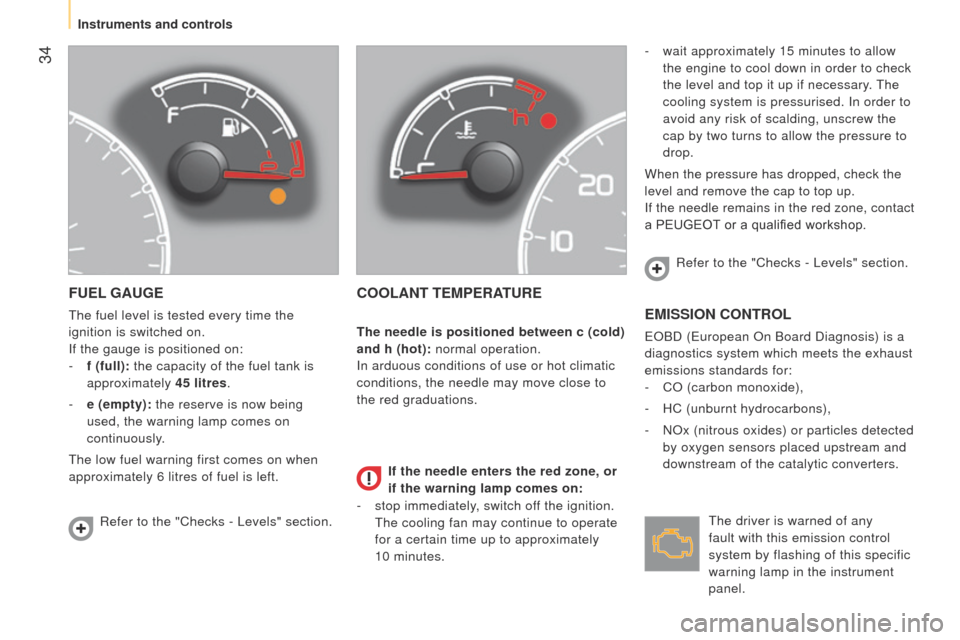
34
Bipper_en_Chap03_pret-a-partir_ed02-2014
FUEL GAUGE
the fuel level is tested every time the
ignition is switched on.
If the gauge is positioned on:
-
f (full):
the capacity of the fuel tank is
approximately 45 litres.
-
e (empty):
the reserve is now being
used, the warning lamp comes on
continuously.
t
he low fuel warning first comes on when
approximately 6 litres of fuel is left.
COOLANT TEMPERATURE
- wait approximately 15 minutes to allow
the engine to cool down in order to check
the level and top it up if necessary.
t
he
cooling system is pressurised. In order to
avoid any risk of scalding, unscrew the
cap by two turns to allow the pressure to
drop.
When the pressure has dropped, check the
level and remove the cap to top up.
If the needle remains in the red zone, contact
a PEUGEOT or a qualified workshop.
EMISSION CONTROL
eOBD (european On Board Diagnosis) is a
diagnostics system which meets the exhaust
emissions standards for:
-
CO (carbon monoxide),
-
HC (unburnt hydrocarbons),
-
NOx (nitrous oxides) or particles detected
by oxygen sensors placed upstream and
downstream of the catalytic converters.
Refer to the "Checks -
l
evels" section. Refer to the "Checks -
l evels" section.
t
he driver is warned of any
fault with this emission control
system by flashing of this specific
warning lamp in the instrument
panel.
If the needle enters the red zone, or
if the warning lamp comes on:
The needle is positioned between c (cold)
and h (hot): normal operation.
In arduous conditions of use or hot climatic
conditions, the needle may move close to
the red graduations.
-
stop immediately
, switch off the ignition.
t
he cooling fan may continue to operate
for a certain time up to approximately
10
minutes.
Instruments and controls
Page 37 of 192

35
Bipper_en_Chap03_pret-a-partir_ed02-2014
SERVICE INDICATORENGINE OIL WARNING LAMP
L IGHTING DIMMER
the dimmer is active when the sidelamps
are on.
Refer to the list of checks in the
warranty and maintenance record
which was given to you on delivery of
the vehicle.
After a few seconds, the screen returns to its
usual functions.
u
se these controls to adjust the
brightness of the instrument
panel and the audio system panel
lighting.
t
he screen in the instrument panel
informs you when the next service is due,
in accordance with the Manufacturer's
servicing schedule indicated in the warranty
and maintenance record.
t
his information
is determined in relation to the distance
travelled since the previous service. Low engine oil pressure
Oil deterioration (1.3 HDi 75 hp engine only)
t
he warning lamp comes on
continuously, accompanied by a
message in the instrument panel
screen, when the system detects
that the oil pressure is too low.
t
he warning lamp flashes,
accompanied by a message in the
instrument panel screen, when the
system detects deterioration of the
engine oil.
t
he flashing of this warning lamp
should not be considered as a fault wit the
vehicle, but rather as an indication to the
driver that the normal use of the vehicle now
requires that the oil be changed.
If the oil is not changed, when a
second level of deterioration is
reached, the emissions warning
lamp comes on in the instrument
panel and the engine speed is restricted to
3000 rpm.
to avoid damaging the engine, it is
recommended that the oil be changed
on flashing of the engine oil warning lamp.
Stop as soon as it is safe to do so: park,
switch off the ignition and contact a
PEUGEOT dealer or a qualified workshop. If the oil is still not changed, when a third
level of deterioration is reached, the engine
speed is restricted to 1500 rpm, so as to
avoid any damage.
3
READY TO SET OFF
Instruments and controls
Page 38 of 192
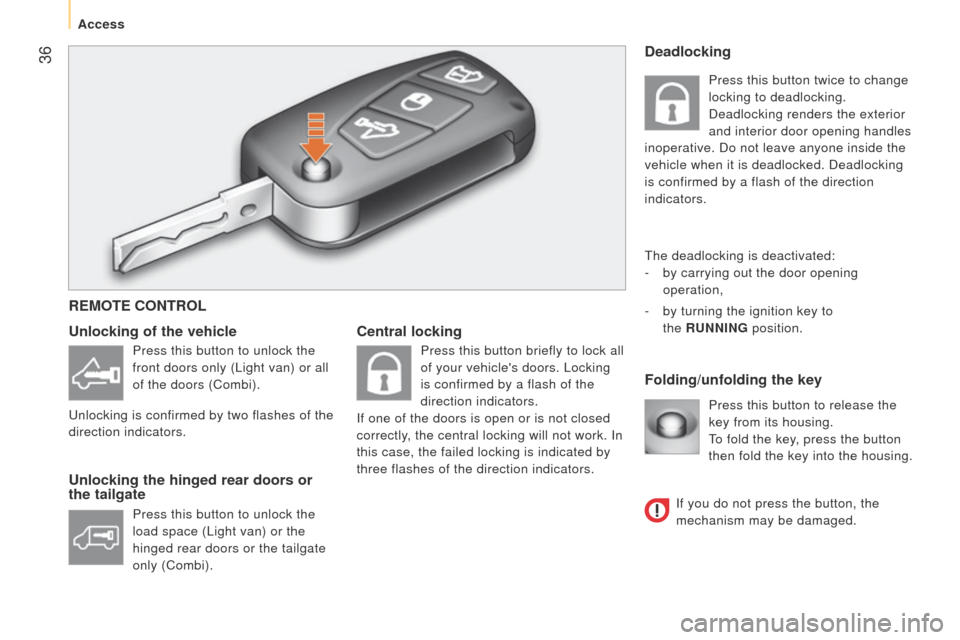
36
Bipper_en_Chap03_pret-a-partir_ed02-2014
Central lockingFolding/unfolding the key
Unlocking of the vehicle
Unlocking the hinged rear doors or
the tailgate
Press this button to release the
key from its housing.
to fold the key
, press the button
then fold the key into the housing.
Deadlocking
the deadlocking is deactivated:
-
by carrying out the door opening
operation,
-
by turning the ignition key to
the
RUNNING
position.
REMOTE CONTROL
Press this button to unlock the
front doors only (l ight van) or all
of the doors (Combi).
u
nlocking is confirmed by two flashes of the
direction indicators.
Press this button to unlock the
load space (
l ight van) or the
hinged rear doors or the tailgate
only (Combi). Press this button briefly to lock all
of your vehicle's doors.
l ocking
is confirmed by a flash of the
direction indicators.
If one of the doors is open or is not closed
correctly, the central locking will not work. In
this case, the failed locking is indicated by
three flashes of the direction indicators. Press this button twice to change
locking to deadlocking.
Deadlocking renders the exterior
and interior door opening handles
inoperative. Do not leave anyone inside the
vehicle when it is deadlocked. Deadlocking
is confirmed by a flash of the direction
indicators.
If you do not press the button, the
mechanism may be damaged.
Access
Page 41 of 192
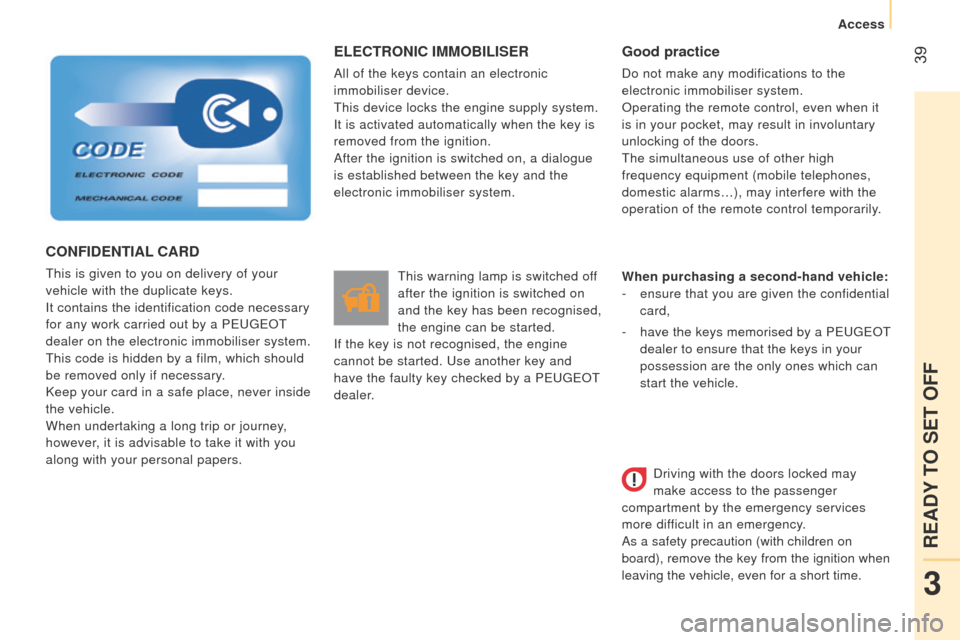
39
Bipper_en_Chap03_pret-a-partir_ed02-2014
ELECTRONIC IMMOBILISER
All of the keys contain an electronic
immobiliser device.
t
his device locks the engine supply system.
It is activated automatically when the key is
removed from the ignition.
After the ignition is switched on, a dialogue
is established between the key and the
electronic immobiliser system.
t
his warning lamp is switched off
after the ignition is switched on
and the key has been recognised,
the engine can be started.
If the key is not recognised, the engine
cannot be started.
u se another key and
have the faulty key checked by a P
e
uge
Ot
dealer
.
Good practice
Do not make any modifications to the
electronic immobiliser system.
Operating the remote control, even when it
is in your pocket, may result in involuntary
unlocking of the doors.
t
he simultaneous use of other high
frequency equipment (mobile telephones,
domestic alarms…), may interfere with the
operation of the remote control temporarily.
When purchasing a second-hand vehicle:
-
ensure that you are given the confidential
card,
-
have the keys memorised by a P
euge O t
dealer to ensure that the keys in your
possession are the only ones which can
start the vehicle.
CONFIDENTIAL CARD
this is given to you on delivery of your
vehicle with the duplicate keys.
It contains the identification code necessary
for any work carried out by a P
euge O t
dealer on the electronic immobiliser system.
t
his code is hidden by a film, which should
be removed only if necessary.
Keep your card in a safe place, never inside
the vehicle.
When undertaking a long trip or journey,
however, it is advisable to take it with you
along with your personal papers. Driving with the doors locked may
make access to the passenger
compartment by the emergency services
more difficult in an emergency.
As a safety precaution (with children on
board), remove the key from the ignition when
leaving the vehicle, even for a short time.
3
READY TO SET OFF
Access
Page 42 of 192
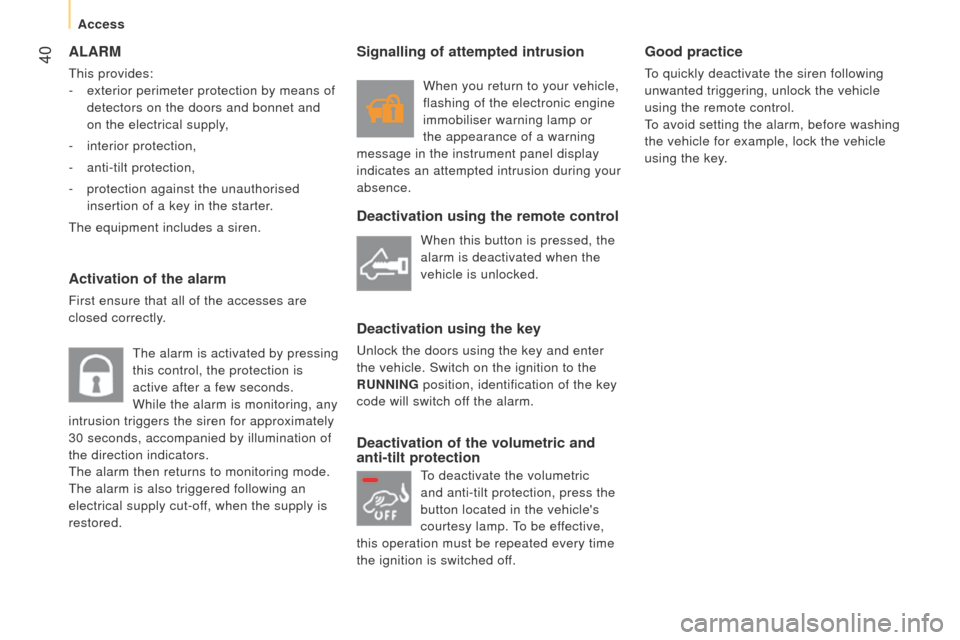
40
Bipper_en_Chap03_pret-a-partir_ed02-2014
ALARM
this provides:
-
exterior perimeter protection by means of
detectors on the doors and bonnet and
on the electrical supply,
-
interior protection,
-
anti-tilt protection,
-
protection against the unauthorised
insertion of a key in the starter.
t
he equipment includes a siren.
Activation of the alarm
First ensure that all of the accesses are
closed correctly.
t
he alarm is activated by pressing
this control, the protection is
active after a few seconds.
While the alarm is monitoring, any
intrusion triggers the siren for approximately
30 seconds, accompanied by illumination of
the direction indicators.
t
he alarm then returns to monitoring mode.
t
he alarm is also triggered following an
electrical supply cut-off, when the supply is
restored.
Deactivation using the remote control
Deactivation using the key
unlock the doors using the key and enter
the vehicle. Switch on the ignition to the
RUNNING position, identification of the key
code will switch off the alarm.
Deactivation of the volumetric and
anti-tilt protection Good practice
to quickly deactivate the siren following
unwanted triggering, unlock the vehicle
using the remote control.
to avoid setting the alarm, before washing
the vehicle for example, lock the vehicle
using the key.
When this button is pressed, the
alarm is deactivated when the
vehicle is unlocked.
Signalling of attempted intrusion
When you return to your vehicle,
flashing of the electronic engine
immobiliser warning lamp or
the appearance of a warning
message in the instrument panel display
indicates an attempted intrusion during your
absence.
to deactivate the volumetric
and anti-tilt protection, press the
button located in the vehicle's
courtesy lamp.
to be ef
fective,
this operation must be repeated every time
the ignition is switched off.
Access
Page 46 of 192
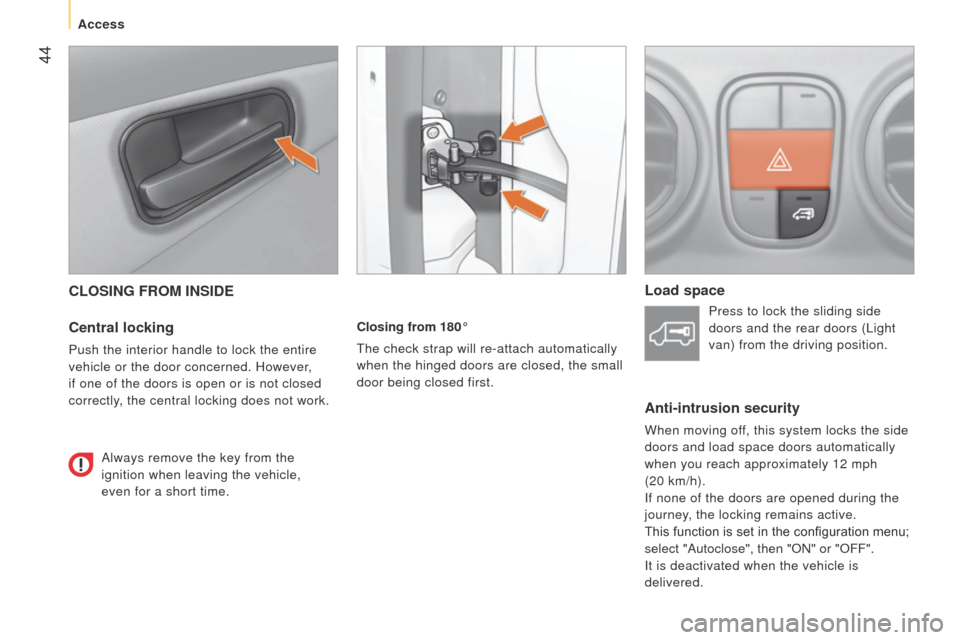
44
Bipper_en_Chap03_pret-a-partir_ed02-2014
CLOSING FROM INSIDE
Central locking
Push the interior handle to lock the entire
vehicle or the door concerned. However,
if one of the doors is open or is not closed
correctly, the central locking does not work.Always remove the key from the
ignition when leaving the vehicle,
even for a short time. Closing from 180°t
he check strap will re-attach automatically
when the hinged doors are closed, the small
door being closed first.
Load space
Press to lock the sliding side
doors and the rear doors ( l ight
van) from the driving position.
Anti-intrusion security
When moving off, this system locks the side
doors and load space doors automatically
when you reach approximately 12 mph
(20
km/h).
If none of the doors are opened during the
journey, the locking remains active.
This function is set in the configuration menu;
select "Autoclose", then "ON" or "OFF".
It is deactivated when the vehicle is
delivered.
Access
Page 47 of 192

45
Bipper_en_Chap03_pret-a-partir_ed02-2014
Sliding side door (Combi)
use the grab handle to pass the point of
resistance and start the movement.
t
hen
use the handle to guide the door closed.
Child safety
this prevents either of the rear doors being
opened from inside.
F
t
urn the switch on each rear door a
quarter of a turn using the ignition key.
CLOSING FROM THE OUTSIDE
Sliding side door
Pull the handle towards you then towards
the front to pass the point of resistance
(
l ight van) or to release the door retaining
device (Combi).
Slide the door fully until it is closed.
Hinged rear doors
Start by closing the small hinged door, this is
secured automatically when closed.
Close the large door using its handle.
Tailgate (Combi)
lower the tailgate using the interior grab
handle.
If your vehicle is on a slope, guide the
sliding door all the way until closed.
t
his is because the door could open or close
itself more quickly because of the incline
and result in injuries.
3
READY TO SET OFF
Access
Page 48 of 192

46
Bipper_en_Chap03_pret-a-partir_ed02-2014
LIGHTING STALK
Selection is by rotation of the white mark
on the ring, when the ignition key is in the
RUNNING position.
All lamps off
Sidelamps on
this is indicated on the instrument panel
by illumination of the warning lamp.
Dipped / main beam headlamps on
Dipped / main beam headlamps
change
Pull the lighting stalk fully towards you.
Headlamp flash
Direction indicators "Motorway" function
System which indicates a change of lane on
high-speed roads.
Press the lighting stalk up or down once,
without passing the point of resistance; the
corresponding direction indicators will flash
three times.
Pull the lighting stalk towards you
gently, regardless of the position
of the ring. Left: push downwards.
t
he green
direction arrow warning lamp
flashes in the instrument panel.
Right: push upwards.
t
he green
direction arrow warning lamp flashes in the
instrument panel.
turn the ring into position.
Parking lamps
Side markers for the vehicle by illumination
of the sidelamps on the traffic side only.
Ignition key in the STOP position or removed
from the ignition switch:
F
turn the ring to the "
l ighting off" position,
then to the "Sidelamps" position,
F
operate the lighting control stalk up
or down depending on the traffic side
(for example: when parking on the left;
lighting control stalk upwards; the right
hand sidelamps are on).
t
his is confirmed by illumination of the
sidelamps warning lamp in the instrument
panel.
to switch of
f the parking lamps, return the
lighting control stalk to the middle position
and the ring to the "
l ighting off" position.
Steering mounted controls